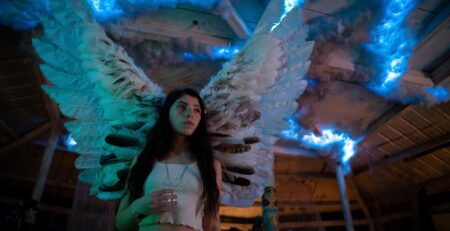Blue Giant was the best animated film of 2023, and now, you can watch it on Blu-Ray, thanks to Gkids. Filled with the emotional complexity that only jazz can capture, Blue Giant has become a touchstone for me. It offers a look at doing what you love, letting it push you to grow, and ultimately defining who you are creatively. Directed by Yuzuru Tachikawa (Mob Psycho 100), Blue Giant mixes artistic styles to bring to life managka Shin’ichi Ishizuka’s story with iconic musician Hiromi behind its score.
If you’re unfamiliar, Blue Giant follows Dai Miyamoto. His life is turned upside down the day he discovers jazz, becoming one of the most renown players in Japan. Told with a documentary framing clearly at the end of his career, Tachikawa brings us through Dai’s life and, more importantly, the jazz trio he played with as a teen. We watch as Dai picks up a saxophone and begins practicing day and night, determined to become one of the greatest of all time. He leaves his hometown, Sendai, for the bustling nightclubs of Tokyo but soon finds the life of a professional musician is not easy. Propelled by his passion, he meets the talented pianist Yukinori and convinces his friend Shunji to learn the drums, allowing them to launch a new jazz trio.
We spoke with director Yuzuru Tachikawa about the process of adapting Blue Giant, the importance of jazz in Japan, and more.
BUT WHY THO: What inspired you to take on the project of adapting Blue Giant into a feature film?
YUZURU TACHIKAWA: Toho wanted to make Blue Giant into a feature film and brought the manga to me. That’s when I read the original story for the first time. I read the first ten volumes in one day, but I felt the story would be better as a TV series. This is because as a film, it would become an overview, and I’d be forced to cut out good moments in the story. However, I heard the author say “I want the audience to experience jazz in the best acoustic environment,” and I resonated with that, so that’s how film production began.
BUT WHY THO: The musical sequences of Blue Giant have a unique sense of movement and life. How did you and the team decide to mix animation styles for these moments?
YUZURU TACHIKAWA: I held meetings with the crew to discuss the meaning of each of the live shows and to choose the right approach to express it. This is so we could control where to make cuts and the colors we chose
to use. We used hand drawing or rotoscope for an abstract feel for the solo performances, while we used CG-like motion capture and camera movement for the head of the songs.
BUT WHY THO: The film’s writing is impeccable, but in many scenes, the score and the music speak for the characters. We can see their growth in their performances. What was the process of working with the composer to bring the manga’s silent pages to life?
YUZURU TACHIKAWA: I didn’t know much about jazz, so I had discussions with the composer bringing the point of view of the audience member with not much jazz knowledge, while the author knows jazz very well, so he
would have a different discussion with the composer. The composer needed to respond to both of our directions. This is the process we repeated. Based on this, I asked for a performance that would communicate the character’s feelings during the live shows. It was quite a laborious process.

BUT WHY THO: The finale sequence, where the film’s title comes into focus, was emotional for me. Was there a performance that resonated with you? And why?
YUZURU TACHIKAWA: My favorite is the final live performance because you can experience the moment of a miracle happening. The three characters know they’ll be taking different paths in life, and perhaps they’ll never play together again. That’s why they put their souls into each moment of that performance. I really love watching all of those emotions building up throughout that scene.
BUT WHY THO: For some who don’t know how important Jazz is in Japan, Blue Giant may be the first time they hear Japanese musicians performing Jazz. How do you feel to potentially introduce this to a new audience? What do you hope they take away from it?
YUZURU TACHIKAWA: After the film’s release, I heard that younger audiencegoers were going to jazz clubs and I was happy to hear that. It’s ultimately the best to experience a performance in-person and since the author wanted to accomplish that through the film, I’m happy these younger people are looking to experience jazz in a great environment. The performer is communicating their feelings through music, so I’d wish the audience to take that in using all five senses. Of course, there’s musical technique, but emotional expressions, sweat, and even the smell is all part of jazz.
At its core, Blue Giant is a uniquely human experience that showcases the complexity that music holds. It showcases how it connects people, pushes people to evolve, and ultimately can be the only way that they speak to the parts of themselves they may not want others to see.
A take on jazz that also looks at the human experience, Blue Giant is a must-watch. The film is available for purchase on Blu-ray, and the manga it’s based on is localized in English by Seven Seas Entertainment and available in omnibus form.
Our interview with Yuzuru Tachikawa was conducted via email.





